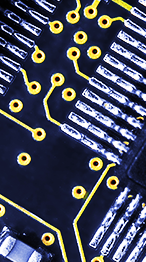|

|
Course Description:
This course involves the
design and implementation of digital systems,
including a team design project.
CAD tools, project design methodologies, logic synthesis, and assembly language programming.
This course was an early innovator
using FPGAs as a central part of a required undergraduate curriculum,
as originally implemented in Fall 1999 when GT transitioned from
quarters to semesters.
This course was a central part of the new Computer Engineering Curriculum,
and a central course for all undergraduate ECE majors.
The original individuals who developed this course
were two staff members,
Thomas R. Collins &
Mark D. Furman,
and
two TAs,
Tyson S. Hall, and
Christopher M. Twigg.
Tyson and Chris were early innovators in mixed-signal and analog
reconfigurable devices,
large-scale Field Programmable Analog Arrays (FPAA),
and were both my Ph.D. students.
Lectures and Labs:
Lecture is 1 hour long; lab is 3 hours long.
There are 8 lectures and 8 labs,
excepted for the in-class Exam,
the remaining weeks of the semester will be dedicated to the final project.
Open Lab:
Additional open lab hours will be held as needed,
typically immediately after the scheduled lab times.
You may use the lab during other class sections provided there is enough equipment.
However, priority always goes to students in the current section.
Course Objectives:
-
implement combinational logic circuits both with TTL devices on a protoboard and within a complex FPGA.
-
analyze the timing of digital circuits with oscilloscopes and logic analyzers.
-
design and implement state machines to meet design specifications.
-
design circuits with a graphical schematic CAD editor.
-
simulate circuits within a CAD tool and compare to design specifications.
-
design, implement, and simulate circuits using VHDL.
-
implement a simple computer within a PLD.
-
write machine language programs and assembly language programs for the simple computer.
-
use a complex sequential logic circuit as part of a solution to an open-ended design problem.
-
write laboratory reports and documentation conforming to technical writing standards.
-
work effectively as team members to develop and write a group report.
-
work effectively as team members to design an approved project.
Textbook:
Additional books:
Thomas R. Collins and Christopher M. Twigg,
Digital Design Laboratory Manual (2nd Edition) ISBN: 978-0757571572
H. O. Hamblen, T. S. Hall, and M. D. Furman,
Rapid Prototyping of Digital Systems: SOPC Edition ISBN: 978-0387726700
Leslie C. Perelman, James Paradis, and Edward Barrett,
The Mayfield Handbook of Technical & Scientific Writing ISBN: 978-1559346474
(Available on-line at http://www.mhhe.com/mayfieldpub/tsw/home.htm)
Other Materials:
- ECE 2031 Workbook
- ECE 2031 Chip Set
- Wire Kit
Honor Code :
You are expected to uphold the honor code
All violations will be referred to the Dean of Students for investigation and penalties.
|